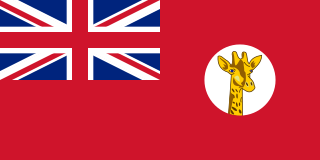Kenya, Uganda, Tanganyika (KUT) is the name on British postage stamps made for use in the British colonies of Kenya, Uganda, and Tanganyika. The stamps were circulated between 1935 and 1963 by the joint postal service of the three colonies, the East African Posts and Telecommunications Administration, reconstituted as part of the East African High Commission from 1948 to 1961, the East African Common Services Organization from 1961 to 1967, and the East African Community from 1967 to 1977. Even after independence, the new separate nations continued to use the KUT stamps, and they remained valid for postage until 1977.

Kenya Rugby Union (KRU) is the governing body for rugby union in Kenya. It was founded in 1970 and is affiliated to Rugby Africa and the international governing body World Rugby.

The Safari Sevens is an annual rugby sevens tournament held in Nairobi, Kenya. The Safari Sevens is open to international representative sides, professional and amateur clubs, invitational teams, university and school teams.

The Uganda national rugby union team are a national sporting side of Uganda, representing them at rugby union. Rugby union was introduced by the British during colonial rule and Uganda played their first international game against Kenya in 1958. They have not yet qualified for the Rugby World Cup.

The Kenya national rugby union team, commonly known as the Simbas, is the country's national team managed by the Kenya Rugby Union. The team plays in red, green, and black jerseys with black or white shorts. The Simbas represent Kenya in the Africa Cup and various other tournaments across the continent. They currently rank thirty-third in the World Rugby Rankings and fourth in Africa. Kenya is yet to qualify for the Rugby World Cup.
The following is a list of the political history of East Africa.

Rugby union in Kenya is a popular sport, in particular due to the success of the Kenya national rugby sevens team in the rugby sevens format, and tournaments such as the Safari Sevens, which has been growing yearly, and now includes numerous international teams.

The Tanzania national rugby union team represents Tanzania in international rugby union. They are known as the Twigas. Tanzania is a member of the International Rugby Board.

The Elgon Cup is contested between the rugby union teams of Kenya and Uganda. The men's and women's teams of these countries each compete annually for their respective cups on a Home-and-Away basis. The competition and the cups are named after Mount Elgon, a mountain on the border of the two countries.

Rugby union in Uganda has been played since colonial times when it was introduced by the British. The governing body is the Uganda Rugby Football Union.

Tanganyika was a colonial territory in East Africa which was administered by the United Kingdom in various guises from 1916 until 1961. It was initially administered under a military occupation regime. From 20 July 1922, it was formalised into a League of Nations mandate under British rule. From 1946, it was administered by the UK as a United Nations trust territory.
Rugby union in Tanzania is a minor but growing sport.

Established in 1950, the East Africa rugby union team is a multi-national rugby union team drawing players from Kenya, Uganda and Tanzania, though the vast majority of these came from Kenya which has traditionally been the strongest rugby playing nation in the region. The team has played against incoming international, representative and club touring sides and it conducted seven tours between 1954 and 1982.

The RFUEA Ground is a rugby union stadium located on the Ngong Road in Nairobi, Kenya. It was purpose built to be the home of the national team and to serve as the headquarters of the Rugby Football Union of Kenya (RFUK). Coincidentally, the RFUEA ground has another parallel with Twickenham Stadium in the United Kingdom in that it also serves as the home ground for the Kenya Harlequin Football Club, just as their sister club the London Harlequins once played at Twickenham.

The Enterprise Cup is an annual rugby union competition in Kenya, Tanzania and Uganda, though the competition frequently has the appearance of being an all-Kenyan affair as the majority of rugby clubs in the African Great Lakes region are based in this one country and frequently clubs in Tanzania and Uganda are unable to take part due to financial constraints. The original cup was donated by sailors from HMS Enterprise, who had toured British East Africa in 1928. The only years in which the competition has not been played is between 1940–1946 due to World War II and in 1987 because an international rugby competition was held on RFUEA Ground as part of the All Africa Games.
Rugby union in East Africa is almost entirely an amateur sport. It has been played in the three East African nations for more than a century; the first recorded match taking place in 1909, though it was almost certainly being played for several years prior to this. There are many club and school teams, the oldest of which were established in Colonial times.

The Scorpions RFC is an invitation rugby team in East Africa that was established upon principles that have many parallels with the Barbarian F.C. in terms of values, playing style, selection policy and the lack of a home ground. The team wears black shirts and white shorts and, like the original Barbarians and the French Barbarians, players wear socks of their choice provided that they have played for the team that the socks represent.

This is a survey of the postage stamps and postal history of Uganda.
The East African Court of Appeal (EACA) was a court which served as the appellate court for the British colonies in eastern Africa and west Asia.













